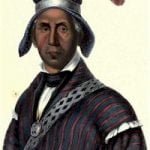
On the 29th of March, 1836, as the main body of the American troops in Florida was about to encamp on the banks of the Ocklewahah, two fires were discovered, newly lighted, on the opposite side of one of those lakes which abound in this country. Supposing them to be signal-fires, lighted by the Indians to communicate intelligence from one party to another, Colonel Butler’s command was detached in search of the enemy. The troops had proceeded three or four miles, when four Indians were discovered and pursued by the advanced guard. General Joseph Shelton, of South Carolina, a gallant gentleman, who accompanied the army as one of a band of volunteers from that patriotic state, dashed for ward and charged upon one of the Indians, who, finding he could not elude the attack, halted and faced his opponent. When but a few steps apart, both parties leveled their guns at each other; the General fired first, wounded his adversary in the neck, and, drop ping the gun, drew a pistol. Advancing on the Indian, he placed the pistol at his breast, and drew the trigger, but the weapon missed fire. The Indian brought his rifle to his shoulder and shot the General in the hip; at the same moment the brave savage received a fatal wound from another hand, fell on his knees, attempted to load his rifle in that position, and died, resisting to the last gasp with the obstinacy which always marks the death of the Indian warrior.
Near the scene of this reconnoiter were several lodges, forming a temporary hamlet, whose inmates had been hastily scattered by the approach of the troops. Here, among the few articles abandoned by the inhabitants in their flight, were found forty or fifty human scalps, the sad memorials of the vindictiveness of savage warfare. They were attached to small pine sticks, in the form of flags, so as to be used at the dances and feasts of the warriors, when these trophies are exultingly displayed. The locks of hair attached to some of them were long and fine, and were evidently those of women, perhaps of young and beautiful women, who had fallen under the edge of the tomahawk; some were the scalps of children and gray-haired men; and all were preserved with equal care, as if the warrior regarded with the same pride the slaughter of the helpless and the defeat of an able adversary.
The warrior who was slain in the manner just described, was Yaha Hajo, or the Mad Wolf, a Creek chief, who visited Washing ton City in 1826 as one of the delegates from that nation, but after wards emigrated to Florida, where he held the same rank. His name is not expressive of his character, which was comparatively mild and benevolent. He was especially noted as a successful hunter, and was considered one of the best in Florida. For this exercise he seemed admirably fitted by his finely molded form, which evinced both strength and agility, and exhibited a fine specimen of savage beauty. He was erect and slender. His chest was broad and high, his limbs round, and elegantly turned, and his muscles greatly developed by constant exercise. The hands of the Indians, never being employed in labor, are usually small, bearing that evidence of gentility which Sir Walter Scott lays down as an indubitable sign of aristocratic birth. Those of Yaha Hajo were remarkably small and delicately formed; while his feet had the hollow sole and high instep common to his race, and might have served as models for the sculptor, except that they were too small for just proportion. His nose was Roman, and all his features fine and prominent.
The Mad Wolf was the second principal war-chief of the Seminoles, and was one of the deputation of seven chiefs appointed to examine the country west of the Mississippi, assigned to the Florida Indians by the treaty of Payne’s Landing, and who reported favor ably; and also one of the sixteen who signed the treaty at Fort Gibson, ratifying that of Payne’s Landing. But although thus far committed on the subject, and favorably disposed towards emigration, he united with the majority of the people in their opposition to it, and became an active leader in the war. The truth is, that the measures adopted to bring about this result, were neither conciliatory nor efficient; the wishes and interests of the Indians, in several particulars, were not consulted as they should have been, nor were the means for effecting the removal forcibly, either adequate or promptly applied.
We find in Mr. Cohen’s book a report of a phrenological examination of the head of this chief, which we shall copy, because it will be interesting to those who have confidence in phrenology, not because we have any faith in it ourselves.
“Exceedingly circumspect in all his actions, he must have been remarkable for persevering in every undertaking on which he had determined, how cruel soever the means. His cunning and courage ably fitted him for the station he is supposed to have held among his countrymen; acquisitiveness, although very large, would not, from its relative size, have formed a prominent feature in his character. His eloquence must have been of the persuasive kind, and his images not wanting in boldness his attachments must have been firm. The recollection of events and places is strongly marked on his skull, but the reflective organs are small. Grave in his demeanor, moderate mirthfulness, large love of approbation.”
